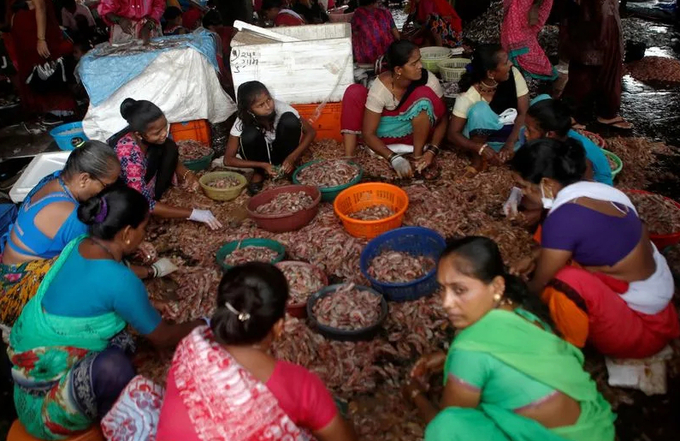May 18, 2025 | 16:28 GMT +7
May 18, 2025 | 16:28 GMT +7
Hotline: 0913.378.918
May 18, 2025 | 16:28 GMT +7
Hotline: 0913.378.918

Women clean prawns at a fish market amidst the spread of the coronavirus disease (COVID-19), in Mumbai.
India has emerged as the biggest supplier of seafood, particularly frozen shrimps, to the United States, with exports doubling over eight years to $2.6 billion in 2022/23, one of the officials at the Commerce Ministry told a small group of reporters.
Total frozen shrimp exports topped $5.6 billion in 2022/23, according to commerce ministry estimates.
"The government intends to focus on value addition and supply to high-end markets while creating awareness about good labour and environment practices among exporters," the officials said.
Shrimp farming has emerged as a big opportunity for nearly 200,000 workers, mainly women in the Southern states of Andhra Pradesh, the second official said, noting, however, that global demand could remain weak this fiscal year.
Both officials declined to be named as they were not authorised to speak to the media ahead of a general election which begins this month.
China, the European Union, South East Asia, Japan and Middle Eastern countries have also emerged as major markets for India's frozen shrimp, produced in village ponds. Other seafood like frozen fish, octopus and cuttlefish is also finding international buyers.
Responding to a report on exploitative labour practices of some shrimp exporters, released by the Chicago-based Corporate Accountability lab, a human rights legal group, officials said the allegations were "baseless" and possibly driven by trade rivalry with other countries and the U.S. industry.
Commerce ministry officials will meet seafood exporters and take up the issue with the state government to ensure all export houses meet the expectations of buyers and overseas consumers, the first official said.
To rule out any buyer concerns, the government could consider an independent study of the working conditions, he said.
Separately, the Federation of Indian Export Organisation (FIEO), the top exporter body, has said shrimp exporters were complying with food safety and quality norms to meet the requirements of importing nations including the U.S..
($1 = 83.4497 Indian rupees)
(Reuters)

(VAN) Fourth most important food crop in peril as Latin America and Caribbean suffer from slow-onset climate disaster.

(VAN) Shifting market dynamics and the noise around new legislation has propelled Trouw Nutrition’s research around early life nutrition in poultry. Today, it continues to be a key area of research.

(VAN) India is concerned about its food security and the livelihoods of its farmers if more US food imports are allowed.

(VAN) FAO's Director-General emphasises the need to work together to transform agrifood systems.

(VAN) Europe is facing its worst outbreak of foot-and-mouth since the start of the century.

(VAN) The central authorities, in early April, released a 10-year plan for rural vitalization.

(VAN) Viterra marked a significant milestone in its carbon measurement program in Argentina, called Ígaris, reaching 1 million soybean hectares measured.